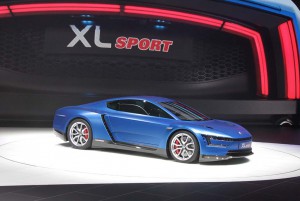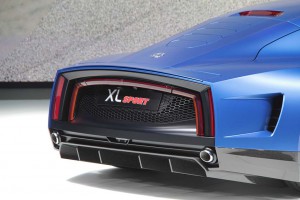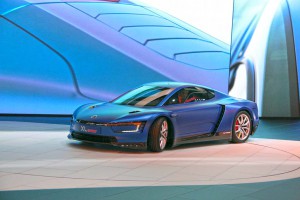What happens when you combine the world’s most fuel-efficient production car with the world’s most powerful two-cylinder engine? You come up with the Volkswagen XL Sport.
Based on the 238 mile per gallon VW XL1, the lightweight and ultra-aerodynamic platform is taking on a decidedly different character thanks to the Ducatti Superleggera V-Twin engine stuffed under its hood.
Set to make its official debut at this week’s Paris Motor Show, VW plans to produce the 168 mph XL Sport in a limited run of just 500 copies. The maker hasn’t set a price tag yet, but the 250 XL1 hyper-milers carried an MSRP of around $250,000.
The XL Sport, declares a Volkswagen release, “is a compelling blend of efficiency and emotion.”
It shares many of the underlying basics that debuted with the Volkswagen XL1 which set an all-time fuel-efficiency record when it debuted several years ago. That starts with an ultra-light body and platform made of carbon fiber and magnesium, the entire XL Sport weighing in at just 1,967 pounds.
The chassis, however, has been redesigned to enhance its performance characteristics. That includes the use of some high-strength steel, notably, VW explains, for the “subframes which house upper and lower control arms at the front with pullrod actuation for the dampers, while the control arms at the back have pushrods — similar to the layout for a racing car.”
The XL Sport, meanwhile, opts for magnesium alloy wheels which shave 53 pounds of mass compared to traditional aluminum alloy wheels. The little racer rides on 205/40 R18 tires up front and 265/35 R18 rear high-performance rubber. Carbon fire brakes provide maximum stopping power while also holding down weight.
As with the two-seat XL1, the XL Sport opts for a carbon-fiber body with fixed polycarbonate windows.
And, as with the hyper-miling XL1, the VW XL Sport adopts LED headlamps and an ultra-aerodynamic shape that is nearly as windswept as a fighter jet.
But the shape has been modified slightly to put the emphasis on “uncompromising driving dynamics,” the maker declares, rather than fuel efficiency. Nose-to-tail, it measures 168.9 inches, compared with 153.1 for the XL1. At 72.7 inches, the XL Sport is about 7 inches wider, while the wheelbase has been stretched nearly 8 inches, to 95.4 inches. Both vehicles stand just 45.4 inches tall.
A number of additional details have been added to ensure high-speed stability, VW says, as well to ensure proper powertrain cooling. But both the Sport and XL1 are notable for their lack of sideview mirrors, opting instead for lipstick-sized cameras built into the body, their images displayed on small video monitors on either side of the cabin.
(VW plugs in with new battery Passat GTE. For more, Click Here.)
Also, like the XL1, there is no conventional radiator grille up front. Air is drawn in through vents by the rear fenders.
(Click Here for details on Jaguar’s new XE Sport sedan in the U.S.)
And the XL Sport needs plenty of it considering it is drawing power from the high-revving Ducatti Superleggera V-Twin. That engine can turn a screaming 11,000 RPMs and blast out a full 197 horsepower, a record for a two-cylinder engine, and 99 pound-feet of torque.
Credit advanced features such as titanium connecting rods, desmodromic valvegear, and magnesium-alloy components with boosting performance to the max. There also are twin fuel injectors in each cylinder.
(To see more about why Subaru WRX drivers get the most speeding tickets, Click Here.)
VW claims the XL Sport will launch from 0 to 60 in just 5.8 seconds, with its top speed set at 168 mph.
The maker plans to produce 500 copies, though it has yet to set a price or announce a production date. It also hasn’t revealed fuel economy numbers, though the XL Sport isn’t likely to come near the record 238 mpg of the XL1.


![VW XL Sport - rear 3-4]](/wp-content/uploads/2014/10/VW-XL-Sport-rear-3-4-300x200.jpg)

